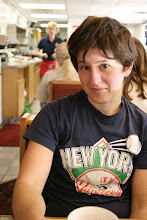 I'm getting ready to make a new drawing about the photographers behind anonymous snapshots using pictures like the ones above, where the shadow of the photographer is present in the composition. An advisor, Glen Helfand, told me there was a publication called The Book of Shadows that showcases a personal collection of similar photographs to the ones I've been gathering together for the past year. I spent an hour in my studio today catching up on all my notes from past advisor visits, figuring out all the books that I should have read over break, but haven't (Bahktin's writing on chronotopes, Gertrude Stein's Tender Buttons, Heideger's The Thing, and on and on and on). Long story short, when I looked up "Book of Shadows" I got a million results, but none that fell under Glen's description-- we're talking millions and millions of really serious Wiccan texts.
I'm getting ready to make a new drawing about the photographers behind anonymous snapshots using pictures like the ones above, where the shadow of the photographer is present in the composition. An advisor, Glen Helfand, told me there was a publication called The Book of Shadows that showcases a personal collection of similar photographs to the ones I've been gathering together for the past year. I spent an hour in my studio today catching up on all my notes from past advisor visits, figuring out all the books that I should have read over break, but haven't (Bahktin's writing on chronotopes, Gertrude Stein's Tender Buttons, Heideger's The Thing, and on and on and on). Long story short, when I looked up "Book of Shadows" I got a million results, but none that fell under Glen's description-- we're talking millions and millions of really serious Wiccan texts.So I started looking for books about shadows and wound up thinking about witches, and then started thinking about magic, and then fairies, and then how one of my girl scout camp counselors (named Tucker) had a Tinkerbell tattooed on her leg, and then about Peter Pan who, of course, has a little altercation with his shadow in the beginning of that fabulous story. Everything always comes around full circle. I like how Peter Pan's shadow is this feisty autonomous character who needs to get sewn back onto the bottoms of his feet. I don't like how, in the cartoon at least, Peter's feisty shadow (who eventually gets tamed) is female. I do like that Peter Pan is played by Julie Andrews in the 1976 musical production.
When I look at photographs, I feel like I'm seeing through the same lens that the photographer did. To some extent, I suppose this is how the audience is always engaged when looking, as inquisitive, as the author of their own opinions of what they're looking at. To some extent, I suppose, it's really different-- I'm looking at a piece of paper and the photographer was looking through a glass lens. I can never experience the noise of that photograph, the weather, the mood, the back story. But the actual composition, the choice and view of the person taking the photograph-- the cropping, the light, the depth of field, the focus, etc-- are all there in the image that I'm looking at, and I feel invited to pretend that I was there (or am there) too. What I like about these photographs with the photographers shadow is that the photographer is so present-- I hate how there's an inherent clinical approach to looking at photography that omits the authorship of the photographer. I'm a drawer, so I love that my hand is so obvious in the things that I make. But I also recognize that my hand is just a tool for my head, that a photographer has a head, that our heads make choices and that choices are what makes us unique and what makes us authors.
The shadow also seems to open the composition up-- way back when as a freshman in college looking at quattrocento Florentine altarpieces, John Paoletti repeatedly pointed out how the compositions were painted to imply a window or continuity between the 'real world' and the painted one. I like the shadows in these photographers because it's like they are mine. I especially like that my dress changes-- sometimes I'm wearing a top hat, sometimes with long hair or a flippy bob-cut, sometimes there is someone standing next to me. For the drawing I'm about to start I'm still troubleshooting over what medium to use (pen, watercolor, pencil, etc...) and also trying to figure out how much information to render and how much to omit. For now, I think I'll just draw the shapes of the shadows, the lively/ghostly/feisty/solitary shapes that they are-- and really, because I think that shadows are cool enough to stand alone. Fuck Peter Pan and his unintentional chauvinism. Our shadows are the silhouetted shape of how the moving sun is shining around our moving bodies as we stand on a moving earth, dependent upon us, but also defiant and autonomous, often unflattering, always moving, unreproducible, fluid.

No comments:
Post a Comment